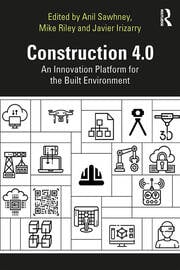CONSTRUCTION 4.0
An Innovation Platform for the Built Environment
Edited by Anil Sawhney, Mike Riley and Javier Irizarry
A new book on Construction 4 from Routledge. As the table of contents below show, it is a comprehensive review of the state of play as the technologies of industry 4 get adapted and adopted to construction. The book is good evidence that the built environment industries can (should? will?) be a leading sector for application of these technologies. From the book's introduction:
Modelled on the concept of Industry 4.0, the idea of Construction 4.0 is based on a confluence of trends and technologies that promise to reshape the way built environment assets are designed, constructed, and operated. With the pervasive use of Building Information Modelling (BIM), lean principles, digital technologies, and offsite construction, the industry is at the cusp of this transformation. The critical challenge is the fragmented state of teaching, research, and professional practice in the built environment sector. This handbook aims to overcome this fragmentation by describing Construction 4.0 in the context of its current state, emerging trends and technologies, and the people and process issues that surround the coming transformation.
Construction 4.0 is a framework that is a confluence and convergence of the following broad themes discussed in this book:
• Industrial production (prefabrication, 3D printing and assembly, offsite manufacture)
• Cyber-physical systems (actuators, sensors, IoT, robots, cobots, drones)
• Digital and computing technologies (BIM, video and laser scanning, AI and cloud computing,
big data and data analytics, reality capture, Blockchain, simulation, augmented
reality, data standards and interoperability, and vertical and horizontal integration)
The book has 28 chapters. Part 1 has 4 chapters discussing the idea of cyber-physical systems. Part 3 has 4 case studies. The core of the book is Part 2 where the elements of C4.0 are identified and current developments explained. These chapters are:
Potential of cyber-physical systems in architecture and construction
Lauren Vasey and Achim Menges
Applications of cyber-physical systems in construction
Abiola A. Akanmu and Chimay J. Anumba
A review of mixed-reality applications in Construction 4.0
Aseel Hussien, Atif Waraich, and Daniel Paes
Overview of optoelectronic technology in Construction 4.0
Erika A. Pärn
The potential for additive manufacturing to transform the construction industry
Seyed Hamidreza Ghaffar, Jorge Corker, and Paul Mullett
Digital fabrication in the construction sector
Keith Kaseman and Konrad Graser
Using BIM for multi-trade prefabrication in construction
Mehrdad Arashpour and Ron Wakefield
Data standards and data exchange for Construction 4.0
Dennis R. Shelden, Pieter Pauwels, Pardis Pishdad-Bozorgi, and Shu Tang
Visual and virtual progress monitoring in Construction 4.0
Jacob J. Lin and Mani Golparvar-Fard
Unmanned Aerial System applications in construction
Masoud Gheisari, Dayana Bastos Costa, and Javier Irizarry
Future of robotics and automation in construction
Borja Garcia de Soto and Miroslaw J. Skibniewski
Robots in indoor and outdoor environments
Bharadwaj R. K. Mantha, Borja Garcia de Soto, Carol C. Menassa, and Vineet R. Kamat
Domain-knowledge enriched BIM in Construction 4.0: design-for-safety and crane safety cases
Md. Aslam Hossain, Justin K. W. Yeoh, Ernest L. S. Abbott, and David K. H. Chua
Internet of things (IoT) and internet enabled physical devices for Construction 4.0
Yu-Cheng Lin and Weng-Fong Cheung
Cloud-based collaboration and project management
Kalyan Vaidyanathan, Koshy Varghese, and Ganesh Devkar
Use of blockchain for enabling Construction 4.0
Abel Maciel
